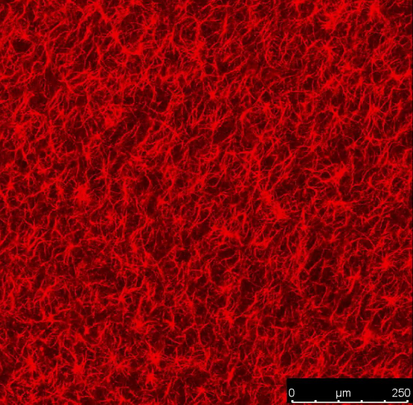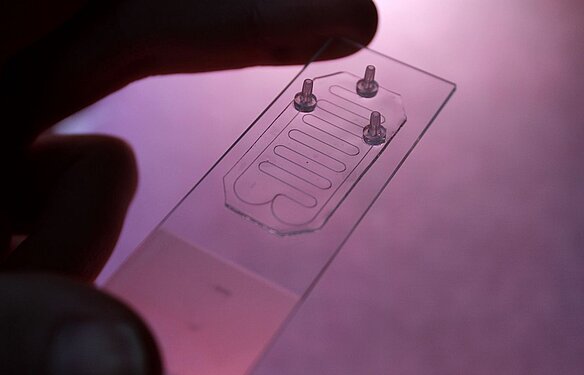Biokompatible und bioaktive Oberflächen
Der Fokus unserer Arbeit liegt auf der Entwicklung neuer intelligenter Biomaterialien, Grenz- und Oberflächen, die eine externe Steuer-/Schaltbarkeit ermöglichen und eine bestimmte Funktionalität aufweisen, vorzugsweise für den biomedizinischen und bioanalytischen Einsatz. Verbunden mit der Entwicklung maßgeschneiderter Methoden, decken wir dabei konzeptionell das gesamte Spektrum von der Grundlagenphysik bis hin zu Anwendungen, wobei wir sowohl Experimente als auch Modellierung einsetzen, um ein möglichst vollständiges physikalisches Verständnis zu erreichen. Aktuelle Forschungsaktivitäten konzentrieren sich auf: i) Elektronenstrahl-unterstützte Synthese biomimetischer und bioderivierter Materialien, ii) magnetisch schaltbare Biomaterialien und Verbundwerkstoffe, iii) biomimetische Oberflächen für organotypische Kultivierung, iv) nanoporöse Materialien, v) Inert-Hüllen-Nanopartikel mit magnetischem Kern vi) nanoskalige aufgelöste mechanische Eigenschaften sowie vii) die Herstellung und Funktionalisierung mikrofluidischer Systeme und Komponenten.
Forschungsthemen
Kontakt
Prof. Dr. Stefan G. Mayr
Leiter
+49 (0)341 235-3368
stefan.mayr(at)iom-leipzig.de
Abteilung Oberflächenphysik, Universität Leipzig
https://research.uni-leipzig.de/ofp/
Highlights
Contact Guidance by Microstructured Gelatin Hydrogels for Prospective Tissue Engineering Applications
M. Tadsen, R. P. Friedrich, S. Riedel, C. Alexiou, S.G. Mayr
Appl. Mat. & Interf. 11 (2019) 7450
https://doi.org/10.1021/acsami.8b21638A novel electron beam assisted imprint lithography is developed to pattern surfaces for tissue engineering applications. The pattern is demonstrated to induce contact guidance in endothelial cells.
Reagent-free programming of shape-memory behavior in gelatin by electron beams: Experiments and modeling
S. Riedel , S. G. Mayr
Phys. Rev. Appl. 9 (2018) 024011
https://doi.org/10.1103/PhysRevApplied.9.024011An electron beam is employed to program a shape memory effect into gelatin. Employing large-scale computer simulation, the physical foundations of the observations are demonstrated.
Interaction of Ferromagnetic Shape Memory Alloys and RGD Peptides for Mechanical Coupling to Cells: from Ab Initio Calculations to Cell Studies
M. Zink, F. Szillat, U. Allenstein, S. G. Mayr
Adv. Func. Mat. 23 (2013) 1383
https://doi.org/10.1002/adfm.201201789In this combined experimental – computational study, the physics of protein adhesion to iron based ferromagnetic shape memory alloys is explored for functionalization and mechanical coupling to cells.
Tailoring Substrates for Long-Term Organotypic Culture of Adult Neuronal Tissue
V. Dallacasagrande, M. Zink, S. Huth, A. Jakob, M. Müller, A. Reichenbach, J. A. Käs, S. G. Mayr
Adv. Mat. 24 (2012) 2398
https://doi.org/10.1002/adma.201200816Nanotube array based scaffolds are developed and demonstrated to allow unprecedented cultivation times of adult tissue explants. This finding paves the way for novel ex-vivo biological studies, drug screening, and personalized medicine.
Ion-Irradiation-Assisted Phase Selection in Single Crystalline Fe7Pd3 Ferromagnetic Shape Memory Alloy Thin Films: From fcc to bcc along the Nishiyama-Wassermann Path
A. Arabi-Hashemi, S. G. Mayr
Phys. Rev. Lett. 109 (2012) 195704
10.1103/PhysRevLett.109.195704We demonstrate that ferromagnetic shape memory alloys deform along the Nishiyama-Wassermann path, when irradiated with energetic electrons.



